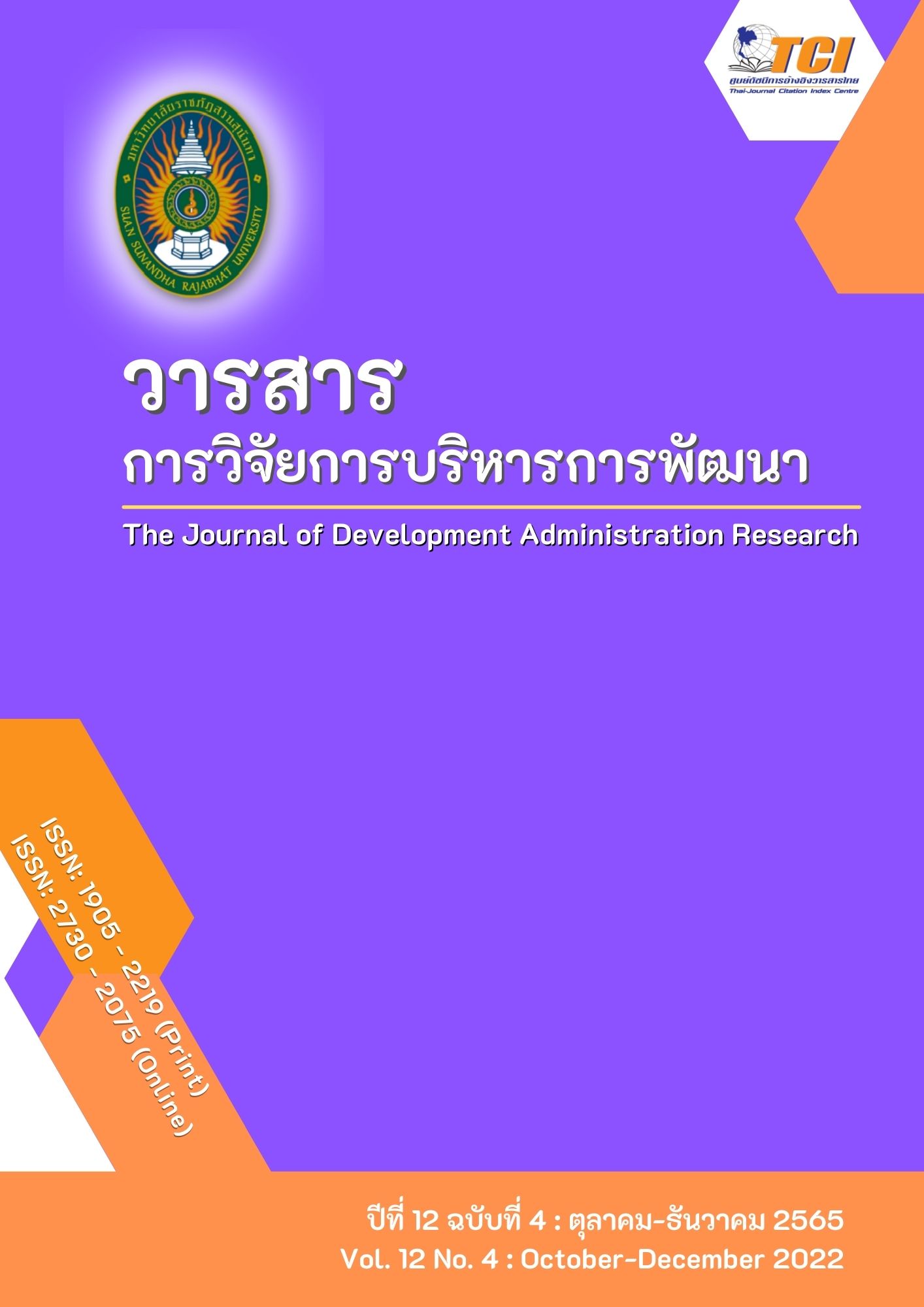The Implication Factors of Thai’s User Adoption toward Banking Technology in the Next Normal
คำสำคัญ:
Banking technology, Next normal, User adoption and Customer Satisfactionบทคัดย่อ
In the world of technology disruption and covid-19 pandemic situation, people are encouraged and forced to use the technology in their daily activities to keep a social distancing. Banking technology has also played a significant role to support these activities. The main purpose of this research was to study the implication factors of Thai’s user adoption toward banking technology in the next normal. The stratified random sampling technique was used to collect four hundred samples from mobile banking users in Thailand. The relationship of observed variables was analysed by structural equation modeling (SEM). The results obtained from the analysis can be seen that perceived ease of use, perceived usefulness and security were influenced to mobile banking adoption and customer satisfaction. The statistical data has displayed the harmony result as follow: 2 = 1.987, df. = 223,
2/ df. = 1.987,
p-value = .050, CMIN = 404.076, CMIN / DF = 1.812, GFI = .977, TLI = .985, AGFI =.988, CFI = .966, RMSEA = .004, at significant level .05. Therefore, banking technology service provider would apply this research for the benefit of understand and increase number of mobile banking users, also prepared for the next normal stage.
เอกสารอ้างอิง
Ameme, B., & Wireko J. (2016). Impact of technological innovations on customers in the banking industry in developing countries. The Business & Management Review, 7(3), 388-397.
Bank of Thailand, (2021). PS_PT_009_S2 Service payment transactions via Mobile Banking and Internet Banking. Retrieved from https://www.bot.or.th/App/BTWS_STAT/statistics/ BOTWEBSTAT.aspx?reportID=949&language=en
Bank of Thailand, (2022). PS_PT_009_S2 Use of Mobile Banking and Internet Banking 1/. Retrieved from www.bot.or.th/App/BTWS_STAT/statistics/BOTWEBSTAT.aspx? reportID =949&language=ENG
Barbu, C. M., Florea, D. L., Dabija, D.-C., & Răzvan Barbu, M. C. (2021). Customer Experience in Fintech. Journal of Theoretical & Applied Electronic Commerce Research, 16(5), 1415–1433.
Bentler, P. M., & Chou, C. P. (1987). Practical issues in structural modeling. Social. Methods Res, 16, 78–117.
Cronbach, L. J. (1963). Educational Psychology. (2nded). New York: Harcourt, Brace and Company
Dewi, S., Riani, A., Harsono, M., & Setiawan, A. I. (2020). Building Customer Satisfaction through Perceived Usefulness. Quality-Access to Success, 21(178), 128-132.
Geebren, A., Jabbar, A., & Luo, M. (2021). Examining the role of consumer satisfaction within mobile eco-systems: Evidence from mobile banking services. Computers in Human Behavior, 114, N.PAG.
Kelloway, E. K. (2015). Using Mplus for Structural Equation Modeling; A Researcher’s Guide. CA: Sage Publications.
Kelly, A. E., & Palaniappan, S. (2019). Survey on customer satisfaction, adoption, perception, behavior, and security on mobile banking. Journal of Information Technology and Software Engineering, 9(259), 1-15.
Kline, R. B. (2010). Principles and Practice of Structural Equation Modeling, 3rd ed. New York: Guilford.
Lee, H., Harindranath, G., Oh, S., & Kim, D. J. (2015). Provision of mobile banking services from an actor–network perspective: Implications for convergence and standardization. Technological Forecasting and Social Change, 90, 551-561.
Masrek, M. N., Halim, M. S. A., Khan, A., & Ramli, I. (2018). The impact of perceived credibility and perceived quality on trust and satisfaction in mobile banking context. Asian Economic and Financial Review, 8(7), 1013-1025.
Murad, S. S., Yussof, S., & Badeel, R. (2022). Wireless Technologies for Social Distancing in the Time of COVID-19: Literature Review, Open Issues, and Limitations. Sensors (14248220), 22(6), 2313.
Olivia, M., & Marchyta, N. K. (2022). The Influence of Perceived Ease of Use and Perceived Usefulness on E-Wallet Continuance Intention: Intervening Role of Customer Satisfaction. Jurnal Teknik Industri, 24(1), 13–22.
Peikari, H. R. (2010). The influence of security statement, technical protection, and privacy on satisfaction and loyalty; a structural equation modeling. In International Conference on Global Security, Safety, and Sustainability (pp. 223-231). Springer, Berlin, Heidelberg.
Phimolsathien, T. (2021). Determinants of the use of financial technology (Fintech) in Generation Y. Utopia y Praxis Latinoamericana, 26(2), 27–35.
Raza, S. A., Umer, A., & Shah, N. (2017). New determinants of ease of use and perceived usefulness for mobile banking adoption. International Journal of Electronic Customer Relationship Management, 11(1), 44-65.
Rehman, Z. U., & Shaikh, F. A. (2020). Critical factors influencing the behavioral intention of consumers towards mobile banking in Malaysia. Engineering, Technology & Applied Science Research, 10(1), 5265-5269.
Sampaio, C. H., Ladeira, W. J., & Santini, F. D. O. (2017). Apps for mobile banking and customer satisfaction: a cross-cultural study. International Journal of Bank Marketing, 35(7), 1133-1153.
Schumacker, R. E., & Lomax, R. G., (2010). A beginner’s guide to structural equation modeling. (3rd ed.). New Jersey: Lawrence Erlbaum Associates.
Singh, S., & Srivastava, R. K. (2018). Predicting the intention to use mobile banking in India. International Journal of Bank Marketing, 36(2), 357-378.
Smith, T., & Geradin, D. (2022). Maintaining a level playing field when Big Tech disrupts the financial services sector. European Competition Journal, 18(1), 129–167.
Tahar, A., Riyadh, H., Sofyani, H., & Purnomo, W. (2020). Perceived ease of use, perceived usefulness, perceived security, and intention to use e-filing: The role of technology readiness. The Journal of Asian Finance, Economics, and Business, 7(9), 537-547.
Tonghui, T., Kongpalee, T., & Chimnoi, A. (2020). Towards a cashless economy:Consumer behavior and opportunities of Thai businesses during COVID-19. Retrieved date 1 October 2021, from https://www.bot.or.th/Thai/ResearchAndPublications/articles/ Pages/Article_21Jul2020.aspx
Venkatesh, V., & Davis, F. D. (2000). A theoretical extension of the technology acceptance model: Four longitudinal field studies. Management science, 46(2), 186-204.
Wilson, N., Alvita, M., & Wibisono, J. (2021). The Effect of Perceived Ease of Use and Perceived Security Toward Satisfaction and Repurchase Intention. Jurnal Muara Ilmu Ekonomi dan Bisnis, 5(1), 145-159.
WHO (2022). WHO Coronavirus (COVID-19) Dashboard. Retrieve 10 October 2021 from https://covid19.who.int/
Xie, J., Ye, L., Huang, W., & Ye, M. (2021). Understanding FinTech Platform Adoption: Impacts of Perceived Value and Perceived Risk. Journal of Theoretical and Applied Electronic Commerce Research, 16(5), 1893-1911.
ดาวน์โหลด
เผยแพร่แล้ว
รูปแบบการอ้างอิง
ฉบับ
ประเภทบทความ
สัญญาอนุญาต
ลิขสิทธิ์ (c) 2022 วารสารการวิจัยการบริหารการพัฒนา

อนุญาตภายใต้เงื่อนไข Creative Commons Attribution-NonCommercial-NoDerivatives 4.0 International License.
บทความที่ได้รับการตีพิมพ์เป็นลิขสิทธิ์ของมหาวิทยาลัยราชภัฏสวนสุนันทา
ข้อความที่ปรากฏในบทความแต่ละเรื่องในวารสารวิชาการเล่มนี้เป็นความคิดเห็นส่วนตัวของผู้เขียนแต่ละท่านไม่เกี่ยวข้องกับมหาวิทยาลัยราชภัฏสวนสุนันทา และคณาจารย์ท่านอื่นๆ ในมหาวิทยาลัยฯ แต่อย่างใด ความรับผิดชอบองค์ประกอบทั้งหมดของบทความแต่ละเรื่องเป็นของผู้เขียนแต่ละท่าน หากมีความผิดพลาดใดๆ ผู้เขียนแต่ละท่านจะรับผิดชอบบทความของตนเองแต่ผู้เดียว




